Corporate Signatures
BlueMind's Signature application allows you to set automatic signatures for all or some users based on certain criteria.
It also allows you to set up a disclaimer message, which is added at the end of all the messages sent by domain users – in addition to the signature – and may include other information (commercial, legal, environmental, etc.).
Corporate signatures are not S/MIME compatible. Neither signatures nor disclaimers will be added to signed or encrypted emails.
Installation and provisioning
Installing the application
To install the new Signature application, install the necessary packages on the BlueMind server and restart BlueMind:
- Debian/Ubuntu
- RedHat
aptitude install bm-plugin-core-signature bm-signature bm-plugin-hps-signature
bmctl restart
yum install bm-plugin-core-signature bm-signature bm-plugin-hps-signature
bmctl restart
Accessing the application
Signatures are managed through a dedicated application - not in the BlueMind admin console. As a result, the super administrator admin0 must appoint users or administrators who can access (or delegate access to) the application to manage domain signatures.
Users or groups of users can be assigned the role "Manage corporate signature" the same way as any other role (see Users - Roles):
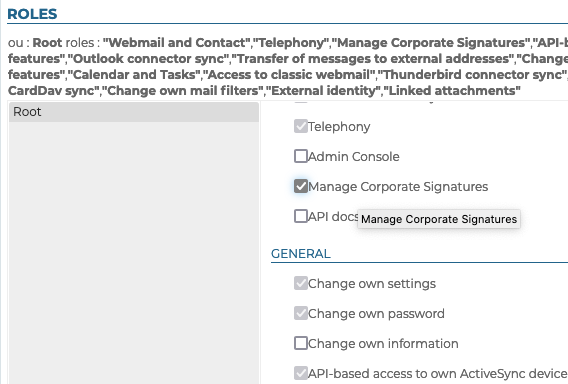
Once the role has been assigned – and having logged back in if necessary – users can access the Signature application from the top ribbon along with other BlueMind applications:

Using the application

The application's main view has three parts:
- at the top, the action buttons can be used to create, sort and test signatures
- the list of signatures and their key characteristics:
- name
- status: enabled, disabled, scheduled
- the senders they apply to
- the recipients they apply to
- edit/delete buttons
- the disclaimer: it has the same characteristics as signatures but it cannot be deleted. A disclaimer is included by default in the application when it is installed, but it remains empty and inactive until it is configured.
Creating signatures
To add a signature, click in the top left corner of the page:
The signature creation page opens:

- Signature name: used to identify the signature in the list. This field is mandatory.
- Activated: check this box to enable or disable the signature.
- Senders: the signature will be applied to all outgoing messages sent by the users selected:
- All senders: all users in the BlueMind domain.
- Sender is: a text box is added. Using autocomplete, enter the name of one or several entities – users or shared mailboxes
- Sender is a member of: a text box is added. Enter one or several groups' names using autocomplete. The signature will be added to the messages sent by users who belong to one or more of these groups. E.g. a specific signature for members of the "Support" group who reply to technical assistance requests, a signature for members of the "Sales" and "Communication" groups who respond to clients' requests.
- Sender is not a member of: a text box is added. Enter one or several groups' names using autocomplete. The signature will be added to the messages sent by users who do not belong to these groups. E.g. a signature for all users who are not part of the management team, a signature for all non-technical users, i.e. those that do not belong to the groups "Support" and "Development".
- Recipients: the signature will be applied to all the messages sent to a type of recipients:
- All recipients: will apply to all messages.
- Internal recipients only: will only be added to messages sent to domain users.
- At least one external recipient: will be added to messages sent (To or Cc) to at least one recipient outside the domain.
Who will see the signature?
The signature is added to the message body, therefore all message recipients will see it.
As a result, when at least a sender/recipient pair matches the signature's filter criteria, the signature will be added to the message and seen by all its recipients.
For instance, a signature is set for the following criteria:
- Sender: is a member of "sales"
- Recipient: external
The Sales Manager Jane (jane@bluemind.loc) writes an email message:
- To:
- Client: client@domaine.swe
- Colleague: john@bluemind.loc
- Cc:
- Accountant: peter@bluemind.loc
==> the sender is a member of the "sales" group AND the client has an external address ==> the signature is added to the message, all its recipients can see it: the client, John and Peter.
Advanced options: this button opens a page with additional options:
Signature validity period: period of time for which the signature will be enabled:
- Permanent: the signature will be applied as long as it is activated
- From: the signature will be applied from the date it is set (inclusive) until it is deactivated
- Until: the signature will be applied from the day it is activated until the set date (inclusive)
- Period: the signature will apply from the start date to the finish date (both inclusive)
Authorize individual signature placement: lets users choose where to place the signature (before or after the message they reply to).
noteIn BlueMind's old webmail and third-party clients (Thunderbird, mobile devices, etc.), users can place this marker when composing a message:
-=+=-=+=-before the signature and+=-=+=-=+after. If a moveable corporate signature is applicable, these two markers and their content will be replaced by the signature. Users can also place these markers into their personal signature.
Remove all previous occurrences: when users reply to a thread of messages, earlier occurrences of their signature are deleted.
HTML signature: signature that will be added to the messages sent in HTML format.
- The WYSIWYG editor allows you to create a signature or import one by copying/pasting one from another source (web creation software, another HTML page or an email message, etc.)
- the
button is used to toggle to HTML editing
- the
menu is used to insert placeholders (see box below)
- the
- The
icon at the end of the row is used to import HTML code from a file (text file, HTML page, etc.).
tipWhen you import an HTML file, a plain text signature is generated automatically if one doesn't already exist.
- The WYSIWYG editor allows you to create a signature or import one by copying/pasting one from another source (web creation software, another HTML page or an email message, etc.)
Plain text signature: a simple signature added to messages sent in plain text format.
The
icon allows you to generate a plain text signature from the HTML signature.
The
icon at the end of the row is used to import text from a file.
Click to save the signature and leave the window.
If you leave the window without saving (using the "x" in the right-hand corner or by clicking outside it), a confirmation dialog will ask you whether you want to leave without saving or return to the window.
Placeholders
Placeholders can be used to customize signatures depending on the sender - e.g. the signature's appearance is the same for all but shows the specific sender's name, telephone number and address.
There are two ways of adding placeholders:
- write the corresponding code starting with "#{", autocomplete then suggests possible placeholders as you type:
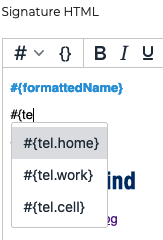
- use the drop-down list to select one:
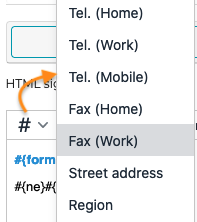
Placeholders match the information in users' contact details cards (as entered by your administrator or through AD/LDAP synchronization) in the domain directory:
- #{formattedName}: full name, made up of prefix+given name+other name+family name+suffix
- #{gender}: gender
- #{name.prefixes}: prefix
- #{name.suffixes}: suffix
- #{name.givenNames}: given name
- #{name.familyNames}: family name
- #{name.additionalNames}: other name
- #{email}: email address
- #{impp}: instant messaging Note: when several instant messaging fields are filled in the user's contact card, the first one in the list will be used.
- #{tel.home}: home phone
- #{tel.work}: work phone
- #{tel.cell}: mobile phone
- #{streetAddress}: street name
- #{region}: region
- #{postOfficeBox}: PO Box
- #{postalCode}: postcode
- #{locality}: town
- #{extendedAddress}: additional address information
- #{countryName}: country
- #{url}: website
- #{role}: position/job title
- #{title}: title
- #{division}: company division
- #{department}: company department
- #{company}: company name
- #{assistant}: assistant's name
- #{manager}: manager's name
- #{fax.work}: work fax number
- #{fax.home}: home fax number
Conditional blocks
If a placeholder is missing in the user's information card, then an empty space is shown.
To avoid this, you can insert a conditional block: if a placeholder is missing in the user's details card, then the entire block will be left out of the signature.
To add a conditional block: select the appropriate text and click :
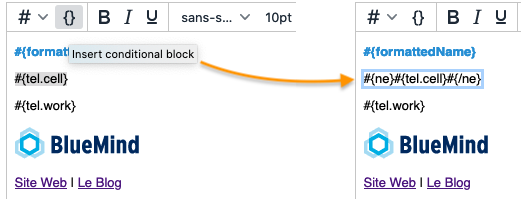
Dans cet exemple, les signatures des utilisateurs ayant un téléphone mobile et un téléphone fixe auront 2 lignes indiquant leurs numéros, les utilisateurs ayant uniquement un téléphone fixe auront une ligne avec leur numéro et les utilisateurs n'ayant aucun téléphone auront une ligne vide (#{tel.work} qui n'est pas conditionnelle) entre leur nom et le logo BlueMind.
Conditional blocks, like placeholders, can also be used in plain text signatures.
The plain text version generated from the HTML signature will appear like this:
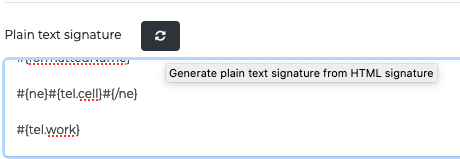
Sorting signatures
Signatures are applied in sorting order. It may therefore be important to sort them in a specific order as when a message matches several signatures' criteria, in that case, the first signature found will be applied.

In this example, the following signatures are set:
- BM all: active
- Documentation: inactive
- Direction: active
If Paul Atréides writes an email, he meets the filter criteria for "Direction" and "BM all" (All senders): as "Direction" comes first in the list, this signature will be used.
If someone in the "Documentation" group wants to write an email, they meet the filter criteria "Documentation" and "BM all": "Documentation" is found first, but it is disabled, therefore the "BM all" will be used.
To sort the list:
- click a signature
- use the
arrows at the top of the page to move a signature up or down.
Activating signatures
Signatures are only applied when they are activated.
By default, new signatures are deactivated. They will be applied only when they are expressly activated.
To activate a signature:
- Open the signature details page
- Check the "Activated" box:
- Save
The activation statuses shown in the application's homepage are:
signature disabled
signature enabled
signature enabled with a set start/end and currently active
signature enabled with a set start/end but not currently active (expired or upcoming)
Editing signatures
In the application's homepage, click the icon at the end of the row for the signature you want to edit to open the signature details page. You can edit it the same way as when you create a signature (see above).
Once the changes have been made, click "Save".
To delete a signature:
- click the
icon at the end of the row for the signature you want to delete
- confirm the deletion when prompted.
To copy a signature you want to use as a template for a new signature:
- select the signature you want to copy
- click the
button at the top of the page.
A new signature is immediately created and named "Copy of..." followed by the name of the original signature.
To test the results and see what the signatures actually looks like in a message:
- Select the signature you want to test
- Click
at the top of the page.
An email is sent to the signature's administrator, in both formats (HTML and plain text), followed by the disclaimer if applicable:
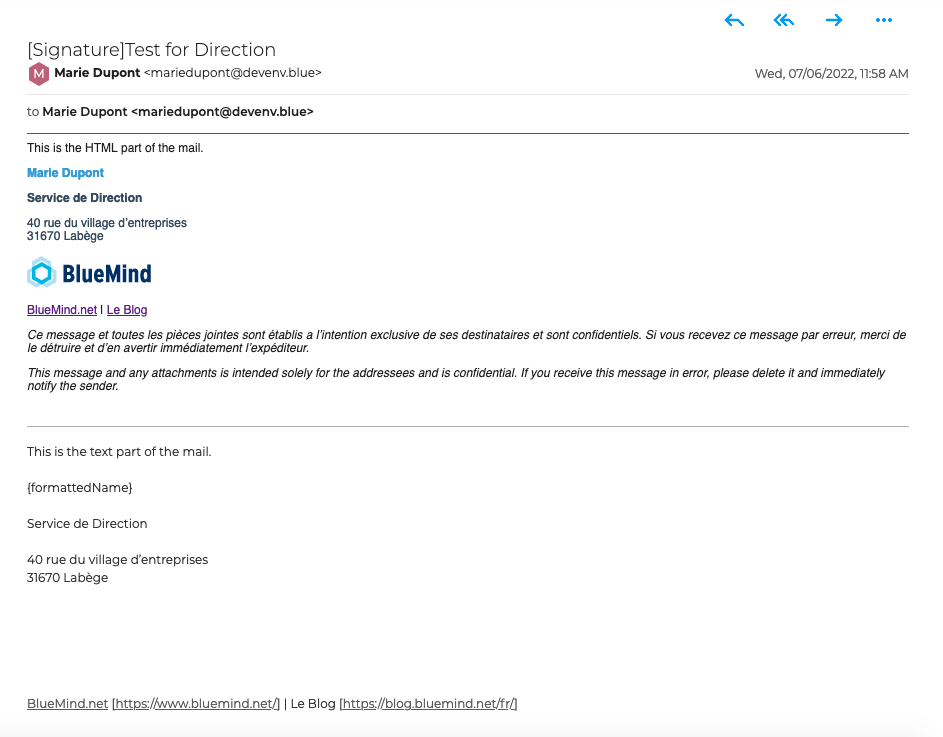
Creating and editing the disclaimer
This message, if enabled, is added to the personal or corporate signature, regardless of the sender.
It may be a legal disclaimer (on confidentiality), a marketing message (company details or special offer) or an environmental warning (a message suggesting not to print the message).
A disclaimer is included in the application by default when it is installed, but it remains empty and disabled until it is configured.
To open the disclaimer editing page, just like for signatures, click the corresponding icon:

The page is almost identical to the signatures page, with two small differences:
the name and senders cannot be edited, it is always called "disclaimer" and applies to all senders
there is no validity period, it is applied as long as it is enabled.
Recipients: 3 choices are available:
- All recipients
- Internal recipients only
- At least one external recipient
HTML signature: HTML code for the signature that will be added to messages sent in HTML format.
The same WYSIWYG editor is used as for signatures, you can therefore create a disclaimer in rich text format.
- Use the
icon at the end of the row to import HTML code from a file
tipWhen you import an HTML file, a plain text signature is generated automatically if one doesn't already exist.
- Use the
Plain text signature: simple signature that will be added to messages sent in plain text format. The
at the end of the row can also be used to import HTML from a file.
Using corporate signatures
Users can see the signature in their message compose window and can choose where to place it:

To find out more about how signatures work for users, please see our user's guide: